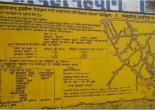- Skip to main content
- Skip to navigation
- Screen Reader Access
- Text Size
- Select Theme Default Theme Yellow Theme Pink Theme Blue Theme
- हिंदी में
About URWSSP :
Uttarakhand Rural Water Supply & Sanitation Project (URWSSP):
| 1 | Period |
Project Start date: 30th November, 2006; Project End date: 31st December, 2015 |
||||||||||||||||||||||
| 2 | Project Development Objective | To improve the effectiveness of rural water supply and sanitation (RWSS) services through decentralization and the increased role of the Panchayati Raj Institutions and the involvement of local communities in the state of Uttarakhand. | ||||||||||||||||||||||
| 3 | Project End Target | Population: 1.2 Million; Habitations: 8270; Open Defecation Free (ODF): 30% of project GPs (470 GPs); Catchment Treatment: 970 Schemes | ||||||||||||||||||||||
| 4 | Implementing Agencies | Uttarakhand Peyjal Nigam (UJN), Uttarakhand Jal Sansthan (UJS) and Project Management Unit, SWAJAL. | ||||||||||||||||||||||
| 5 | Project Cost | The total water sector investment committed is $224 million for the SWAp. Partners for the SWAp pool ($224 million) include Government of India (31%), Government of Uttarakhand (67%); and the User Communities (3%) financial share. The International Development Association will reimburse the Government of Uttarakhand share of SWAp basket up to $120 Million, against an annually varying reimbursement pattern, agreed in the PAD. | ||||||||||||||||||||||
| 6 | Project Components |
|
||||||||||||||||||||||
| 7 | Project Cycle for implementation of the project |
(i) Pre-planning phase: (ii) Planning Phase: (iii) Implementation Phase : (iv) Operation and Maintenance Phase and thereafter : (v) exit |
||||||||||||||||||||||
| 8 | Community Contribution | The upper ceiling of upfront community contribution for private water connection is Rs. 600.00 and Rs. 300.00 for General Category and Schedule Caste/Schedule Tribe (SC/ST) population respectively. In case of public stand post, the upper ceiling is Rs. 300.00 and 150.00 for General Category and SC/ST population. | ||||||||||||||||||||||
| 9 | Uniqueness of the project |
|
||||||||||||||||||||||
| 10 | Innovations at a Glance |
|
||||||||||||||||||||||
| 11 | Impacts |
Communities have the following advantages:
Savings for the State Exchequer: Detailed assessments show that by decentralizing service delivery to local communities, the state government’s savings include: savings in institutional costs and O&M costs. Thus the State Government has to provide lesser budgetary support through State Exchequer as GP meets the O&M expenses including energy costs. Greater Availability of Time for Line Departments: GP/UWSSC takes up the full responsibility of O&M, with back-up support by the UJS, as and when required. Thus line department have more availability of time for managing complex schemes and lesser management problems. Employment Generation:
|
||||||||||||||||||||||
Table 2: Ratings of World Bank Mission: May, 2014
India:Uttarakhand RWSS (Project ID: P083187; Loan/Credit No. 42320)
| Key Project Data | Current Ratings and Flags | ||
| Effectiveness Date | 11/30/2006 | Development Objectives | Satisfactory |
| Closing Date | 12/31/2015 | Implementation Progress | Satisfactory |
| Project Age | 7.6 years | Problem Flags | None |
| % Disbursed as of May, 2014 | 88% Original Project; 74% Original Project plus AF for Disaster Management | ||






